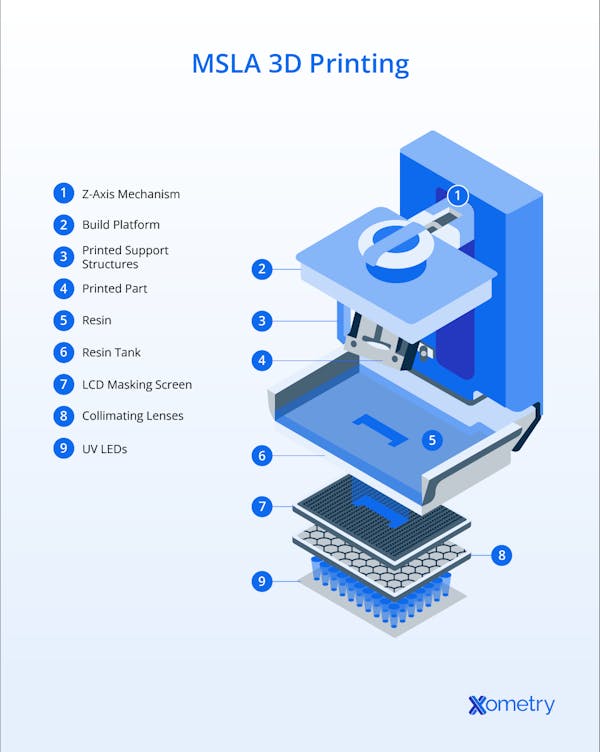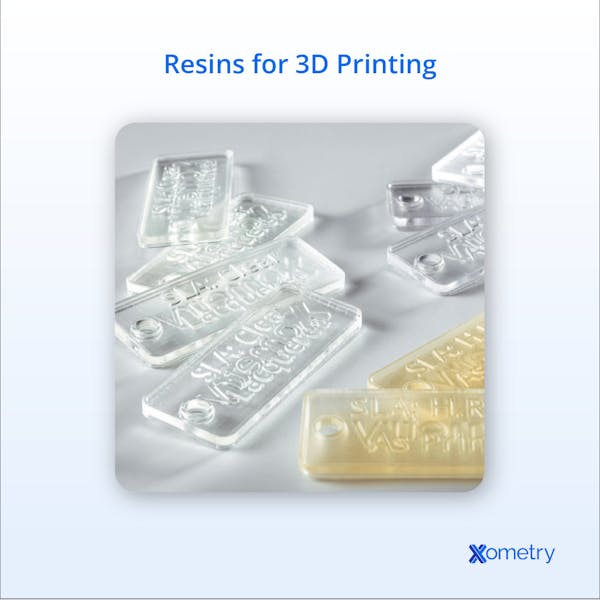MSLA, short for masked stereolithography apparatus, is an enhanced form of SLA (stereolithography) 3D printing that matches an LCD screen with a powerful LED light source to selectively cure photosensitive resin. When successive layers are cured upon the previous ones, they form a three-dimensional object. An LED array is used as the light source and is projected through an LCD screen which acts as a reconfigurable mask.
This technique has several benefits. It is able to produce high-quality items in large quantities at low cost, and do so more quickly and accurately than most 3D printing methods. However, the drawback of MSLA 3D printing is the high cost of the printers themselves; only a select few businesses can afford the technology. Additionally, due to the photosensitive resin's extremely delicate nature and the need for careful handling, this type of 3D printing should be done in complete darkness. A resin tank, digital mask, light array, and build platform make up the MSLA 3D printer's structure. This article will further discuss what MSLA 3D printing is, how it operates, and the materials utilized.
What is Masked Stereolithography Apparatus 3D Printing?
Masked stereolithography apparatus (MSLA) is an enhanced form of SLA 3D printing. The major difference is in the light source. Instead of using a controlled laser beam, MSLA uses a large ultraviolet (UV) light source to cure resins in a layer-by-layer approach until completion. It is important to note that the light source — an array of LED lights — is not directly focused on the thermoplastic resin but instead gets masked by a selectively transparent LCD screen in a controlled way. For more information, see our guide on 3D Printing.
How Does Masked Stereolithography Apparatus 3D Printing Work?
MSLA 3D printing works by placing a photosensitive resin above the LCD and LED array separated by a thin layer of fluorinated ethylene propylene (FEP) plastic. The function of the LCD is to control where light can shine through and impact the resin above. The LCD is made up of individual pixels that allow light to pass through when off and prevent the passage of light when on. This arrangement of pixels matches the shape of each desired layer. The light passes through the LCD, allowing parts of the resin between the build platform and FEP sheet to cure. The build platform then lifts and positions itself for the next layer. Just like other 3D printing methods, the process continues one layer at a time until the part is complete.

| Pros | Cons |
|---|---|
Pros No matter how thick the layer may be, MSLA printers have the primary benefit of curing an entire layer at once. | Cons The equipment is pricey. As a result, stereolithography is not a practical prototyping method for many businesses. |
Pros The majority of modern MSLA printers use monochrome LCDs capable of displaying grayscale pixels along edges. This offers built-in antialiasing capabilities, resulting in smooth printed surfaces. . | Cons The main problem with the MSLA is resin handling. The production must be done in a dimly lit location. This will shield the resin from damage or premature curing. |
Pros Few moving parts are used in MSLA printers. The print bed only moves in the Z axis, except for versions that incorporate tilting beds to reduce peeling pressures. | Cons The fact that MSLA printers must use UV-cured resin limits material options. These materials cannot match the breadth of properties found in other polymers. |
Pros
| Cons Users complain about how messy MSLA printing can be. Because the uncured resin is hazardous, users must wear protective gloves to handle newly-printed parts. Additionally, ventilation is crucial, and printed pieces need to be washed in an alcohol solution. They must sit under intense UV light for 5 to 15 minutes after washing in order to cure fully. |
What is the Material Used in MSLA 3D Printing?
The MSL 3D printing process uses unique photopolymer resins that harden (cure) under UV light. The majority of 3D printing resins are either acrylate- or epoxy-based, with the latter being more common in desktop printers. Most resins fall into one of the following categories:
- Standard Resin: Standard resins work well for printing with great resolution and rigidity. They are best for prototyping.
- Tough Resin: Tough resins are comparable to ABS thermoplastic. They were developed to give printed parts good impact resistance.
- Clear Resin: Clear resins have mechanical qualities comparable to those of standard resin. The difference is that, with a little post-processing, they can be made optically transparent.
- Durable Resin: Durable resin has similar mechanical properties to polypropylene (PP). It is a flexible and wear-resistant material, particularly useful when prototyping consumer products such as ball joints and snap fits.

How is MSLA 3D Printing Used in the Medical Industry?
MSLA 3D printing is used in the process of bioengineering tissue. Various compositions are important here, making possible bone and teeth implants, artificial vascular supports, and organ scaffolds.
How is MSLA 3D Printing Used in the Jewelry Industry?
The great printing resolution of MSLA and the availability of wax resins that will burn out cleanly during casting make it popular in the jewelry industry. Traditional lost-wax casting demands that jewelers cut hard modeling wax into complex shapes. Now, those shapes can be made with more precision using a printer. Moreover, designs that would be impossible with traditional techniques are simple with 3D printers. The designer must simply build the jewelry piece using CAD software beforehand.
Are MSLA Printers Capable of Producing Massive, Detailed Pieces?
Yes, MSLA 3D printers can create large, intricate items if the printer is large enough. The Peopoly Phenom L 3D printer is the go-to machine for such work. It is a dependable high-volume printer that is useful for small-batch production runs and prototyping. In addition to its enormous print capacity and quick drying time, it can efficiently and swiftly produce prototypes and parts. Although this printer is designed to print larger pieces, it can also produce small parts.
What is the Difference Between MSLA and SLA?
SLA and MSLA printers differ in their resin-curing process. While MSLA employs a LCD mask to project UV light to solidify the layers, SLA traces each layer’s shape using an ultraviolet laser instead. Printing is usually quicker via the MSLA process because a single flash of the curing light solidifies an entire layer at once, something the SLA laser cannot do. This makes MSLA especially useful when multiple models are printed simultaneously.
Summary
This article presented Masked Stereolithography Apparatus (MSLA), explained what it is, and discussed how this process is used in different industries. To learn more about MSLA, contact a Xometry representative.
Xometry provides a wide range of manufacturing capabilities, including 3D printing and other value-added services for all of your prototyping and production needs. Visit our website to learn more or to request a free, no-obligation quote.
Disclaimer
The content appearing on this webpage is for informational purposes only. Xometry makes no representation or warranty of any kind, be it expressed or implied, as to the accuracy, completeness, or validity of the information. Any performance parameters, geometric tolerances, specific design features, quality and types of materials, or processes should not be inferred to represent what will be delivered by third-party suppliers or manufacturers through Xometry’s network. Buyers seeking quotes for parts are responsible for defining the specific requirements for those parts. Please refer to our terms and conditions for more information.

